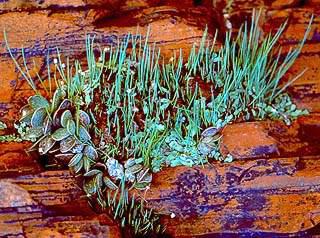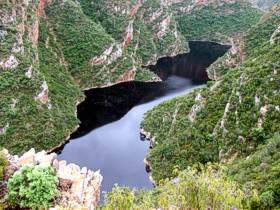Litanthus pusillus
Litanthus pusillus Harv = Drimia uniflora J.C.Manning & Goldblatt
Family: Hyacinthaceae
Common names: TomThumb hyacinth, Kleinduimpie-hiasint (Afr.)
Introduction
The Tom Thumb hyacinth (Litanthus pusilus) is a dwarf bulbous plant, widespread but little known due to its size: William Harvey (1844) who first described the plant refers to it as the smallest bulbous plant on earth. This plant has now been included in the genus Drimia, but the author prefers to retain the old name.

The image above shows the Tom Thumb hyacinth in its habitat growing near Griekwastad on banded ironstone together with Adromischus trigynus. The plant is in leaf and fruit.
Description
Description
This is a dwarf bulbous perennial forming inconspicuous rounded clusters up to 25 mm in diameter. The bulbs are spherical-conical, up to 13 mm in diameter, often growing on top of the substrate; the outer fleshy bulb scales (tunics) are tightly overlapping (imbricate), and grey. The roots are shallow and fibrous. Leaves 1-3, appearing after the flowers (hysteranthous), thread-like (filiform), up to 70 mm long and ascending to spreading-pendulous.
The inflorescence is erect, 17-25 mm high with a solitary (rarely 2) flower(s) and 2 bracts which are up to 1 mm long and spurred at the base. The flowers (perianth) are nodding (pendulous), white to pink, tubular, up to 4 x 2 mm long, with lobes fused for two-thirds of the length of the flower. The stamens are fused to the perianth tube and the anthers are attached at the base (dorsifixed). The ovary is sessile and ellipsoid.
The fruiting capsule is about 3 x 2,5 mm, slightly transparent and contains black, angled seeds about 1 x 0,4 mm.

The image shows the Tom Thumb hyacinth in fruit, grown at Kirstenbosch National Botanical Garden.
Flowering time: summer & midsummer. Flowers are open day and night.
Distribution and habitat
Distribution description
Litanthus pusillus occurs widespread in mountainous regions in the southern and eastern parts of the RSA from the Western Cape to the Limpopo Province.
Derivation of name and historical aspects
History
The name Litanthus pusillus was chosen by Harvey in 1844 and literally means `stone flower'(`lithos' = stone and `anthus' = flower), an appropriate name as the plant grows in stony soil and is difficult to detect due to its small size (`pusillus' = very small). The Tom Thumb hyacinth was first collected by the German collector Carl Zeyher (1799-1858) near the Zwartkops River near Uitenhage. It is closely related to the genus Drimia. In Cape Plants the authors Goldblatt & Manning (2000, p. 713) transferred the genus Litanthus which is monotypic (consists only of one species) to the genus Drimia under the name Drimia uniflora. The author prefers to use Harvey 's name Litanthus pusillus for this unique dwarf plant.
Ecology
Ecology
Litanthus pusillus grows on vertical cliffs and in rock crevices at an altitude of about 200-3000 m in exposed to sheltered kloof's on all aspects, on shale, rhiolite and sandstone. Temperature ranges from warm to cool. Winters are cooler with frost at higher altitudes. Rainfall can occur at any time of year in the south, but mainly during summer in the north-east, ranging from 100-1250 mm per annum. Plants root in crevices, among moss and other succulent plants. The Tom Thumb hyacinth grows in various biomes including Fynbos, Albany Thicket, Nama-Karoo, Succulent Karoo and Afro-alpine grassland. The small seeds are about 1 mm long and 0.4 mm broad, and well suited for crevice establishment. They are blown or shaken from the erect capsules and dispersed by the wind. They ripen during summer and autumn.

The image shows cliffs adjacent to the Kouga Dam, habitat of the Tom Thumb hyacinth (Eastern Cape, South Africa).
Litanthus pusillus proliferates from its base forming small dense clusters. When bulbs become detached they will re-root and continue to grow. This vegetative regeneration can be seen as a back-up which is important for the survival of the species in its harsh cliff face environment.
At the Kouga Dam near Patensie (Eastern Cape, southern region), Litanthus pusillus plants were observed on sheer quartzitic sandstone cliffs (light-coloured and smooth-textured Peninsula Formation, Cape Supergroup) overlooking the Kouga Dam. Plants growing on south-facing slopes share this habitat with succulents such as Crassula nemorosa, Ornithogalum juncifolium, Cotyledon orbiculata var. orbiculata, Crassula nudicaulis, C. pellucida subsp. marginalis, Gasteria glomerata, Othonna triplinervia, Schizobasis intricata and Cyrtanthus flammosus.
On the Soutpansberg (farm Swarthoek, Limpopo Province) plants were observed growing in shallow sandstone pans (altitude higher than 1000 m) sharing their habitat here with other succulents such as Aeollanthus rehmannii, Delosperma sp., and Huernia nouhuysii.

The image shows the plant in flower in its habitat at Leeukloofberg, Eastern Cape, growing together with Crassula nemorosa and Delosperma sp.
Uses
Use
No uses have been recorded.
Growing Litanthus pusillus
Grow
Propagation: Plants are very small and easily overlooked and therefore best grown in small containers. They are not popular due to their diminutive size. Plants are easily grown from seed or by division and thrive in cultivation. The species can be propagated at any time of the year but preferably during spring or summer. Make sure the container provides sufficient drainage. With less light plants rapidly grow longer leaves. Keep them in a dappled shady position and water regularly but less so during winter.
Cultivation: The Tom Thumb hyacinth is best grown as a container plant. It is so small that it would disappear on a rockery. The species is often introduced unwittingly or accidentally with other bulbs or succulent clusters and is often found among clumps of Crassula and Conophytum species or other succulent plants. It grows fairly fast, multiplies rapidly and soon fills the container. It is best treated as a summer grower, but should be gently watered throughout the year. It grows best in a cool situation in a sandy or gravelly soil. Plants can be fed with a mild organic fertilizer such as Bounceback.
References
- Goldblatt, P, & Manning, P. 2000. Cape Plants, a conspectus of the Cape Flora of South Africa. Strelitzia 9. National Botanical Institute and Missouri Botanical Garden.
- Gunn, M.& Codd,, L.E. 1981. Botanical exploration of southern Africa. A.A. Balkema, Cape Town for the Botanical Research Institute.
- Harvey, W.H. 1844. Litanthus, a new genus of Asphodeleae, from South Africa. In W. J. Hooker in the London Journal of Botany 2: 314, 315, t.9.
- Mucina, L., Rutherford, M. & Powrie, L. (eds). 2006. The vegetation of South Africa, Lesotho and Swaziland. Strelitzia 19. South African National Biodiversity Institute, Pretoria.
Credits
Ernst van Jaarsveld
Kirstenbosch National Botanical Garden
February 2009
Plant Attributes:
Plant Type: Bulb
SA Distribution: Eastern Cape, Free State, Gauteng, KwaZulu-Natal, Western Cape
Soil type:
Flowering season:
PH:
Flower colour: White, Pink
Aspect: Full Sun
Gardening skill: Average
Special Features:
Horticultural zones










Rate this article
Article well written and informative
Rate this plant
Is this an interesting plant?
User Comments
Kris Butterfield, United States
October 17, 2017 at 4:56 PMExcellent information about this Crassula and we'll written, too!
So happy to have found this site. I passionately collect & sell many varieties. Also try to provide as close to the natural environment of many S African succulents as possible
Login to add your Comment
Back to topNot registered yet? Click here to register.